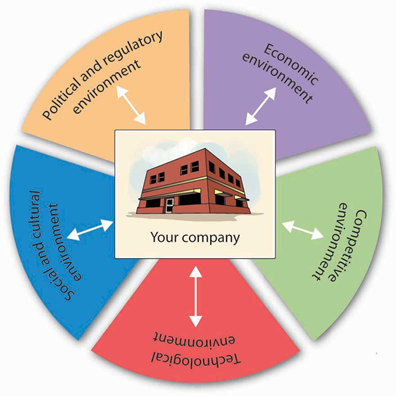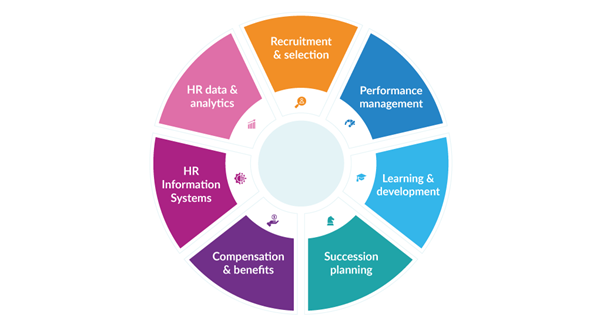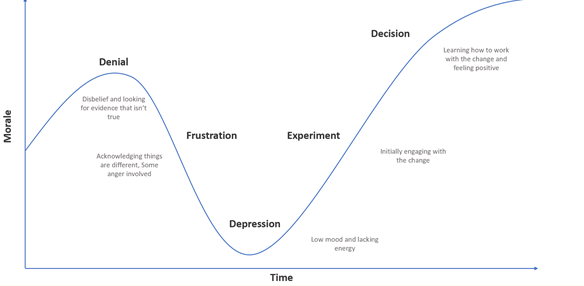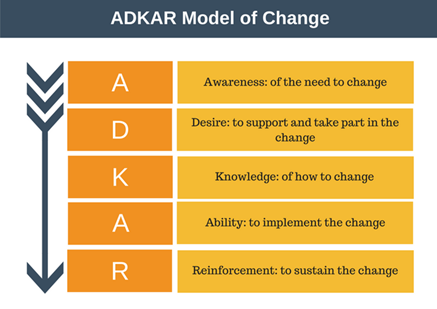Change Management Assignment: Managing Change In Dynamic Environment
Question
Task:
You are supposed to write a detailed change management assignment critically evaluating the following topic:
“Managing change in dynamic environmental is seen as critical element of the corporate strategy. Critically evaluate the strategic role of HRM during change and its impact on employee engagement and ethics".
You are required to conduct a literature review demonstrating that you have researched the viewpoint from all sides of the debate.
Answer
Introduction
The present context of change management assignment sheds light on the concept of change management which is critical in the successful performance of a business organisation. Many reasons can make an organisation decide for a change. The market environment is changing with time. Trends and technologies are being forward and advanced (Baddah, 2017). Under this circumstance, the organisations try to align their business according to the changing external environment. Thus, this can initiate a change process for a business. Also, the internal factors and organisational environment can be the cause of initiating changes. The growth of the company is also ensured with the change management process. Human Resource of an organisation is an unavoidable part of business, and thus, the change management process. Thus, the role of HR in managing changes is essential to be evaluated for a better understanding of this context. Ethics is a vital concern that is needed to be maintained while managing the changes. The change also has an impact on employee engagement. The report will highlight supportive literature to draw concepts on the change management in a dynamic environment. In this study, different secondary sources will be used to effectively evaluate organisational change management in dynamic environments. This study will evaluate the changes that have a direct impact on the human resource of a business.
A. Discussion (Knowledge)
In this part of the study, several relevant information and knowledge are gathered from authentic sources. The organisational environment has a direct impact on the performance of the business. An organisational environment is the specific characteristics of a company that defines or describes the organisation. These also differentiate the organisation from other similar ones. Multiple factors are combined in developing an organisational environment. According to Harbert and Harbert, (2021), organisational factors are influential in defining the environment of an organisation. There are specific modes of operations, leadership, decision-making style, etc. The structure of an organisation is also included in an organisational factor. Some moral factors, such as incentives, rewards, recognition, etc., are considered the external and important factors in developing an organisational environment. Psychological factors are linked with the thoughts and thinking of the employees. All these factors influence the employees and the organisation directly. Thus, the organisational factor has a direct impact on organisational performance.

Figure 1: External factors affecting the business environment
(Source: Vosse and Aliyu, 2018)
As per Vosse and Aliyu (2018), multiple environments make the changes and impact the HRM of an organisation. The change management is placed in different scenarios that occur while running the business organisation. Diversity in the workforce is such a scenario that can ask for changes in the organisations. Cultural diversity in a workplace is needed to be handled with proper strategies in HR. Some organisations decide to have changed while facing economic or technological barriers in the environment. This helps the companies to have the best possible outcome in the business. Advancement in technology is changing the business environment. Thus, the company can have change management in a changing technological scenario. Globalisation can be another scenario while the company can feel the need for changes. In this era, all the businesses are being globalised. The companies are, thus, focusing on globalisation. Therefore, specific changes are being done in the organisations. Restructuring of the organisation is another scene of change management where the organisational structure is changed. Change management helps a lot in managing changes in these mentioned scenarios.
Thakhathi, le Roux and Davis,(2019), stated that HR is the backbone of a business organisation. Therefore, it plays a vital role in change management. In this era, organisations are going through significant changes. The rate of these changes has increased compared to the last decade. As per the research of Gartner, most business organisations have faced five or more organisational changes in the last three years. A considerable percentage of the organisations are thinking that more changes are coming in the upcoming years. Thus, with these frequent change initiatives, the management of the employees and staff are crucial these days. Many significant changes can have different impacts on different organisational levels. As per many corporate managers and leaders, managing the employees during the change is highly important. Lack of management in this segment can be costly to the organisation. This can harm the efficiency and productivity of the company. Thus, strategic human resource management (SHRM) is highly beneficial in managing the employees during the changes. Hence, a strategic leader focuses on developing an effective roadmap and communication plan for the changes.

Figure 2: HR Functions
(Source: Mishra, Shukla and Sujatha, 2021)
According to Mishra, Shukla and Sujatha (2021), an organisation's HR can participate in the change management system of an organisation in different ways. The HR can initiate changes and lead them towards completion. Also, the changes initiated by the other segments of the company can be led by HR. Thus, the role of HR in change management is highly important. Some multiple activities and functions are addressed and practised by HR during the changes. Establishing effective communication is one of those activities. HR helps in tracking the organisational changes and the change management process. Employees and staff of a company are managed by HR during this phase of change. Proper communication is one of the major strategies to make them connected and updated. HR is also responsible for planning and arranging suitable development and training programs for the employees related to the organisational changes. Documentation is another activity done by HR while managing the changes. Analysis of the impacts and readiness of the changes are highly important jobs done by HR.
B. Critical Evaluation
As discussed in the previous segment, the organisational environment has a huge impact on business performance. Therefore, managing the employees properly is a vital concern for the leaders. According to the argument of Mishra, Shukla and Sujatha (2021), there are many challenges that the change management process faces in different organisational environments. The previous segment states that cultural diversity in the workplace can lead to a change in an organisation. The employees can be managed with the new system and changing workplace environment. However, there comes a barrier while working with multiple teams in a process. Managing these teams is not easy for the leader or manager. For this, a proper set of instructions, policies and monitoring processes is needed. Dealing with parallel or simultaneous changes is highly challenging for the HR of a company. Thus, this barrier can be overcome with the help of a proper management process. As mentioned earlier, strategic human resource management is needed to deal with comfortable and effective organisational changes. However, Baddah(2017) argued that following the sets of instructions and a suitable change management model is followed based on the change requirements, situation, company resources, objectives, etc. There are multiple effective change management theories and models that are used in different cases. Step-by-step change management is always controlled and effective in a business structure. However, there can be challenges due to a lack of visibility in the overall change management process. This may lead the changes towards failure.
Ethical leadership is a concept that is highly influential in HRM. Ahmadet al., (2017), contradicted that Ethics helps improve employee satisfaction, and thus, the overall productivity and efficiency of the change process. Ethics is maintained by the leaders while managing the changes in an organisation. However, Sahu, Pathardikar and Kumar,(2017), argued that the concept of ethics is not limited to just following the company policies and business rules. It is about the care for the employees. The concern for the well-being of the employees makes them satisfied and engaged. Focusing on employee benefits can return better employee attachment to the organisations. The ethical leader maintains morality to maintain proper ethics in the process. Without the ethical considerations, the changes face employee dissatisfaction, stress, confusion, and causes lack of productivity.
Kubler-Ross Change Management Framework,
According to the Kubler-Ross Change Management Framework,

Figure 3: Kubler-Ross Change Management Framework
(Source: Cameron and Green, 2019)
- The first stage of change management is Denial. As per Cameron and Green (2019), at this stage, the employees are highly confused and opposes the changes mentally. However, in most cases, it has been observed that ethical change management can omit this stage.
- In the next stage (Anger), the employees feel angry with the leader and the system. This is a psychological journey that is portrayed in this model.At this stage, motivation and ethical leadership are highly recommended.
- The next stage is Bargaining, where the employees wish to have a negotiation with the changes. This enhances employee engagement that is very important for productivity.
- Depression is the fourth stage that needs motivation and effective communication. Unethical practices by the leaders at this stage can fail the flow of the change journey.
- At the last stage (Acceptance), the changes are accepted, and productivity remains maintained.
The role of communication and transparency is also unavoidable at this point. An uncertainty takes place at the initial stage. Moreover, unethical management can raise the anger and denial of the employees. There are many ways of making a change management process unethical. The manager can focus on self-interest rather than the collective interest. Also, unclear information can be provided to the employees regarding the changes. Lack of motivation and increased bullying in the workplace is another unethical practice. These all harm the overall change management process and the productivity of the organisation. At this point, the ADKAR model is used by many companies for different change management practices.
ADKAR Model

Figure 4: ADKAR Model
(Source: Jani?ijevi?, 2017)
- According to this model, the first stage is Awareness. As per Jani?ijevi? (2017), the manager or leader shares their thoughts and views with the employees at this stage. The necessity for the changes is discussed with the help of this model. Thus, this model is highly beneficial in maintaining ethical values in change management.
- The second stage is Desire. This stage is related to employee engagement. The necessity of change is developed and imposed on the employees by communication and presentations.
- Knowledge is the third stage where employees get engaged with the planning and participation in the change process. Hence, this model can improve employee engagement at this stage also.
- The next stage is Ability. At this stage, models and theories are understood, and skills are evaluated. Also, the challenges and barriers are analysed to check the ability.
- The reinforcement stage focuses on the sustainability of the change. HR can take different strategies such as discussing progress, providing incentives and recognitions, celebrating success, etc., to make the changes stable with the system. This also enhanced employee engagement.
Though most ethical concerns are practices and maintained by the managers and leaders in the change management system, the employees also need to have ethics while being a part of the change.
Conclusion
A business organisation can plan for change to overcome internal weaknesses. Also, change is planned for taking the opportunities for business success. Overall, it can be said that change makes a company long-lasting in the respective markets. Effective and successful change management helps a business organisation to deal with the competitors and the market properly.Similarly, as with authoritative change, even smaller changes in initiative methodology can develop powerful results. Associations need to move past broad proclamations of morals, assess the moral upsides of pioneers and their activities, and decide if they are viable with the more extensive interests of the association and its partners. This expects them to comprehend morals both in strategy and useful terms and to be clear about the moral premise of various ways to deal with administration and change. Effective and suffering change sets aside time, which can be devastating to workers at all levels of the connotation. Ethical leaders add to a solid work culture which ultimately leads to the association's achievement over the long-pull. Such workers invest profoundly in addressing their association and consistently think in support of it. As far as they might be concerned, the achievement of their association matters the most. Further, it can be added that HR has an unavoidable and effective role in the change management process. SHRM is used by HR to manage the employees properly. Suitable strategies are developed for the team to get the best result. Tracking all the activities during the change is another vital job for HR in an organisation.
Reference List
Ahmad, M. H., Ismail, S., Rani, W. N. M. W. M., and Wahab, M. H. (2017, October). Trust in management, communication and organisational commitment: Factors influencing readiness for change management in organisation. In Aip conference proceedings (Vol. 1891, No. 1, p. 020019). AIP Publishing LLC.https://aip.scitation.org/doi/pdf/10.1063/1.5005352
Baddah, A. (2017). The Influencing Factors of Organisational Change Management: A Literature Review. Ahi Evran Üniversitesi ?ktisadi ve ?dari Bilimler Fakültesi Dergisi, 1(1), 42-58.https://dergipark.org.tr/en/download/article-file/391751
Cameron, E., and Green, M. (2019). Making sense of change management: A complete guide to the models, tools and techniques of organisational change. Kogan Page Publishers.http://www.uop.edu.pk/ocontents/Change%20Management%20Book.pdf
Harbert, T. and Harbert, T. (2021) How to Manage Change, SHRM. Available at: https://www.shrm.org/hr-today/news/hr-magazine/spring2021/pages/managing-change.aspx
Jani?ijevi?, N. (2017). Organisational models as configurations of structure, culture, leadership, control, and change strategy. economic annals, 62(213), 67-91.http://www.doiserbia.nb.rs/ft.aspx?id=0013-32641713067J
Mishra, P., Shukla, B., and Sujatha, R. (2021). Human Resource Management for Organisational Change: Theoretical Formulations.https://www.taylorfrancis.com/books/mono/10.4324/9781003191346/human-resource-management-organisational-change-paritosh-mishra-balvinder-shukla-sujatha
Rosenbaum, D., More, E., and Steane, P. (2018). Planned organisational change management: Forward to the past? An exploratory literature review. Journal of Organizational Change Management.https://www.optimumnfp.com.au/publications-intro/publications/127-planned-organisational-change-management.html
Sahu, S., Pathardikar, A., and Kumar, A. (2017). Transformational leadership and turnover: Mediating effects of employee engagement, employer branding, and psychological attachment. Leadership and Organization Development Journal.https://www.researchgate.net/profile/Sangeeta-Sahu-2/publication/320910414_Transformational_leadership_and_turnover_Mediating_effects_of_employee_ engagement_employer_branding_and_psychological_attachment/links/5d5168904585153e594f0133/ Transformational-leadership-and-turnover-Mediating-effects-of-employee-engagement-employer- branding-and-psychological-attachment.pdf
Thakhathi, A., le Roux, C., and Davis, A. (2019). Sustainability leaders’ influencing strategies for institutionalising organisational change towards corporate sustainability: A strategy-as-practice perspective. Journal of Change Management, 19(4), 246-265.https://www.researchgate.net/profile/Andani-Thakhathi/publication/331185806_Sustainability_Leaders%27_Influencing_Strategies_for_Institutionalising_Organisational_Change_towards_Corporate_Sustainability_A_Strategy-as-Practice_Perspective/links/5eaf13f4299bf18b95947d6c/Sustainability-Leaders-Influencing-Strategies-for-Institutionalising-Organisational-Change-towards-Corporate-Sustainability-A-Strategy-as-Practice-Perspective.pdf
Vosse, B. J. F., and Aliyu, O. A. (2018). Determinants of employee trust during organisational change in higher institutions. Journal of Organizational Change Management.https://www.emerald.com/insight/content/doi/10.1108/JOCM-05-2017-0203/full/html












